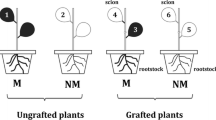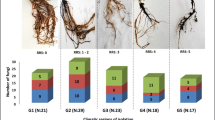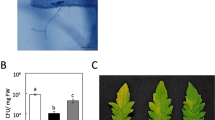Abstract
A time course study was conducted to investigate disease development and molecular defense response in common bean (Phaseolus vulgaris L.) plants colonized by a mixture of five arbuscular mycorrhizal (AM) fungi, namely, Glomus mosseae, G. intraradices, G. clarum, Gigaspora gigantea, and Gigaspora margarita, and post-infected with the soil-borne pathogen Rhizoctonia solani. Results showed that pre-colonization of bean plants by AM fungi significantly reduced disease severity and disease incidence. DNA fingerprinting using the differential display technique revealed a genetic polymorphism (86.8 %) in bean plants that resulted from the colonization by AM fungi. Two genetic mechanisms were recorded: (1) switching on of new genes and (2) induction of other active genes, including the defense genes chitinase and β-1,3-glucanase, to a highly expressed state.





Similar content being viewed by others
References
Abdel-Fattah GM, El-Haddad SA, Hafez EE, Rashad YM (2011) Induction of defense responses in common bean plants by arbuscular mycorrhizal fungi. Microbiol Res 166(4):268–281
Aly MH, Manal YH (2009) Vesicular-arbuscular mycorrhiza and Trichoderma virdi as deterrents against soil-borne root rot disease of sugar beet. Sugar Tech 11(4):387–391
Bishop JG, Ripoll DR, Bashir S, Damasceno CMB, Seeds JD, Rose JKC (2005) Selection on glycine β-1,3-endoglucanase genes differentially inhibited by a Phytophthora glucanase inhibitor protein. Genetics 169:1009–1019
Blee KA, Anderson AJ (1996) Defense-related transcript accumulation in Phaseolus vulgaris L. colonized by the arbuscular mycorrhizal fungus Glomus intraradices Schenck Smith. Plant Physiol 110:675–688
Buttery BR, Park SJ, Findlay WJ (1987) Growth and yield of white bean (Phaseolus vulgaris L.) in response to nitrogen, phosphorus and potassium fertilizer and to inoculation with Rhizobium. Can J Plant Sci 67:425–432
Carling DE, Pope EJ, Brainard KA, Carter DA (1999) Characterization of mycorrhizal isolates of Rhizoctonia solani from an orchid, including AG-12, a new anastomosis group. Phytopathology 89:942–946
Chen YP, Higgins JA, Feldlaufer MF (2005) Quantitative real-time reverse transcription-PCR analysis of deformed wing virus infection in the honeybee (Apis mellifera L.). Appl Environ Microb 71:436–441
Ciavatta ML, Lopez-Gresa MP, Carella A, Manzo E, Nicoletti R (2006) Antagonism towards Rhizoctonia solani and production of a brevioxime-related compound by Penicillium sizovae. J Plant Pathol 88:S37
CoStat (2005) Cohort Software Monterey
Cota IE, Troncaso-Rojas R, Sotelo-Mundo R, Sanchez-Estrada A, Tiznado-Hernandez ME (2007) Chitinase and β-1, 3-glucanase enzymatic activities in response to infection by Alternaria alternata evaluated in two stages of development in different tomato fruit varieties. Sci Hortic 112:42–50
Duncan DB (1955) Multiple range and multiple F test. Biometrics 11:1–24
El-Haddad SA, Abd El-Megid MS, Shalaby OY (2004) Controlling onion white rot by using Egyptian formulated endo-mycorrhiza (Multi-VAM). Ann Agric Sci 49:733–745
El-Khallal SM (2007) Induction and modulation of resistance in tomato plants against Fusarium wilt disease by bioagent fungi (arbuscular mycorrhiza) and/or hormonal elicitors (jasmonic acid and salicylic acid): 2-changes in the antioxidant enzymes, phenolic compounds and pathogen related-proteins. Aust J Basic Appl Sci 1:717–732
El-Tarabily KA (2004) Suppression of Rhizoctonia Solani diseases of sugar beet by antagonistic and plant growth-promoting yeasts. J Appl Microbiol 96:69–75
Garcia-Garrido JM, Ocampo JA (2002) Regulation of the plant defence response in arbuscular mycorrhizal symbiosis. J Exp Bot 53:1377–1386
Garmendia I, Aguirreolea J, Goicoechea N (2006) Defense-related enzymes in pepper roots during interactions with arbuscular mycorrhizal fungi and/or Verticillium dahliae. BioControl 51:293–310
Gooday GW (1999) Aggressive and defensive roles for chitinases. In: Jolles P, Muzzarelli RAA (eds) Chitin and chitinases. Birkhäuser, Basel, pp 157–170
Graham PH (1981) Some problems of nodulation and symbiotic nitrogen fixation in Phaseolus vulgaris L.: a review. Field Crop Res 4:93–112
Guenoune D, Galili S, Phillips DA, Volpin H, Chet I, Okon Y, Kapulnik Y (2001) The defense response elicited by the pathogen Rhizoctonia solani is suppressed by colonization of the AM-fungus Glomus intraradices. Plant Sci 160:925–932
Guillon C, St-Arnaud M, Hamel C, Jabaji-Hare S (2002) Differential and systemic alteration of defence-related gene transcript levels in mycorrhizal bean plants infected with Rhizoctonia solani. Can J Bot 80(3):305–315
Kai M, Effmert U, Berg G, Piechulla B (2007) Volatiles of bacterial antagonists inhibit mycelial growth of the plant pathogen Rhizoctonia solani. Arch Microbiol 187:351–360
Kronland WC, Stanghellini ME (1988) Clean slide technique for the observation of anastomosis and nuclear condition of Rhizoctonia solani. Phytopathology 78:820–822
Lambais MR, Mehdy MC (1998) Spatial distribution of chitinases and β-1-3-glucanase transcripts in bean arbuscular mycorrhizal roots under low and high soil phosphate conditions. New Phytol 140:33–42
Mohr U, Lange J, Boller T, Wiemken A, Vögeli-Lange R (1998) Plant defense genes are induced in the pathogenic interaction between bean roots and Fusarium solani, but not in the symbiotic interaction with the arbuscular mycorrhizal fungus Glomus mosseae. New Phytol 138:589–598
Phillips JM, Hayman DS (1970) Improved procedures for clearing roots and staining parasitic and vesicular-arbuscular mycorrhizal fungi for rapid assessment of colonization. Trans Br Mycol Soc 55:157–160
Pozo MJ, Dumas-Gaudot E, Barea JM (1999) β-1,3-Glucanase activities in tomato roots inoculated with arbuscular mycorrhizal fungi and/or Phytophthora parasitica and their possible involvement in bioprotection. Plant Sci 141:149–157
Shalini S, Kotasthane AS (2007) Parasitism of Rhizoctonia solani by strains of Trichoderma spp. Electro J Environ Agric Food Chem 6:2272–2281
Singh R, Adholeya A, Mukerji KG (2000) Mycorrhiza in control of soil born pathogens. In: Mukerji KG, Chamola BP, Singh J (eds) Mycorrhizal biology. Kluwer, Dordrecht, pp 184–189
Smith MV, Miller CR, Kohn M, Walker NJ, Portier CJ (2007) Absolute estimation of initial concentrations of amplicon in a real-time RT-PCR process. BMC Bioinformatics 8:409
Sneh B, Burpee L, Ogoshi A (1991) Identification of Rhizoctonia species. American Phytopathological Society Press, Saint Paul
SPSS (2004) SPSS® Base 13.0 User’s Guide. SPSS, Chicago
Tarantino P, Caiazzo R, Carella A, Lahoz E (2007) Control of Rhizoctonia solani in a tobacco-float system using low rates of iprodione- and iprodione-resistant strains of Gliocladium roseum. Crop Protect 26:1298–1302
Trouvelot A, Kough JL, Gianinazzi-Pearson V (1986) Mesure du taux de mycorhization VA d’un système radiculaire recherche de methods d’estimation ayant une signification fonctionnelle. In: Gianinazzi-Pearson V, Gianinazzi S (eds) Physiological and genetical aspects of mycorrhizae. INRA Publ, Paris, pp 217–221
Tu CC, Hsieh TF, Chang YC (1996) Vegetable diseases incited by Rhizoctonia spp. In: Sneh B, Jabaji-Hare S, Neate S, Dijst G (eds) Rhizoctonia species: taxonomy, molecular biology, ecology, pathology and disease control. Kluwer, Dordrecht,, pp 369–377
Zeng RS (2006) Disease resistance in plants through mycorrhizal fungi induced allelochemicals. In: Inderjit KG, Mukerji (eds) Allelochemicals: biological control of plant pathogens and diseases. Springer SBM, Dordrecht, pp 181–192
Acknowledgments
The authors extend their appreciation to the Deanship of Scientific Research at King Saud University for funding this work. Our deep gratitude is extended to Dr. Khalid Ghoneem (Plant Pathology Research Institute, Agricultural Research Center) for his sincere help in the fungal identification. Many thanks to all those who have helped us in the Plant Molecular Pathology Lab., Mubarak City for Scientific Research, especially Ms. Ghada Ali.
Author information
Authors and Affiliations
Corresponding author
Rights and permissions
About this article
Cite this article
Hafez, E.E., Abdel-Fattah, G.M., El-Haddad, S.A. et al. Molecular defense response of mycorrhizal bean plants infected with Rhizoctonia solani . Ann Microbiol 63, 1195–1203 (2013). https://doi.org/10.1007/s13213-012-0578-5
Received:
Accepted:
Published:
Issue Date:
DOI: https://doi.org/10.1007/s13213-012-0578-5




